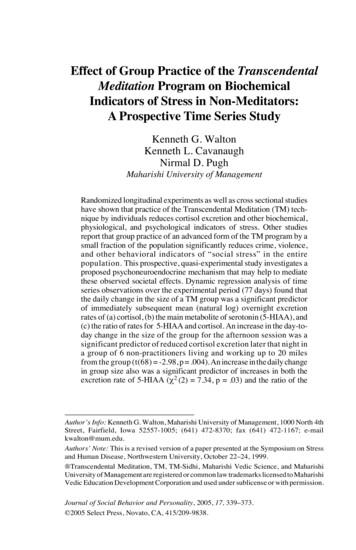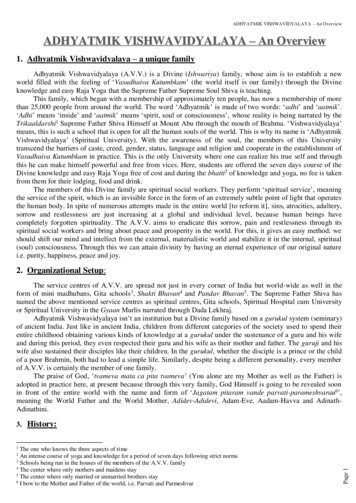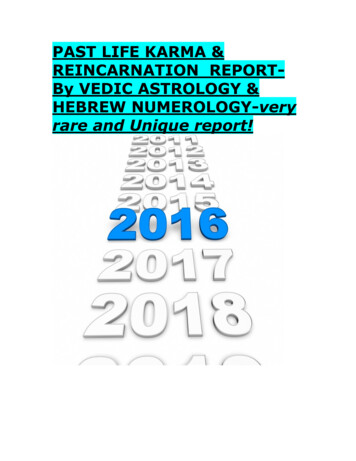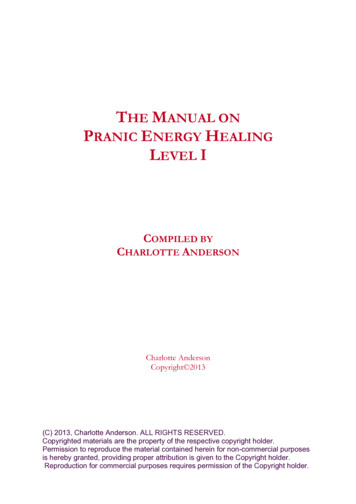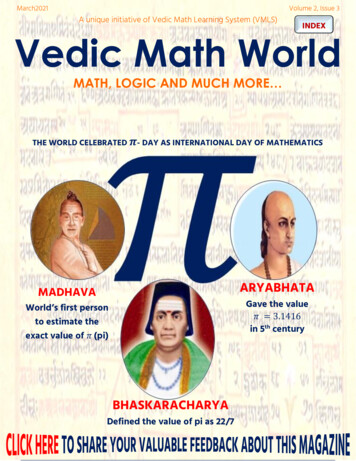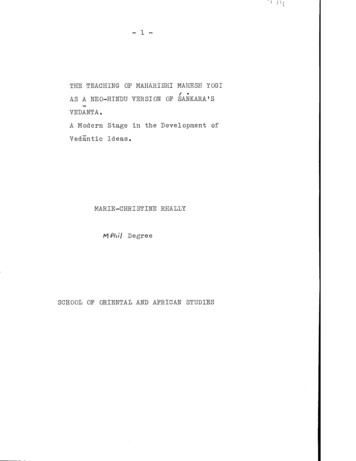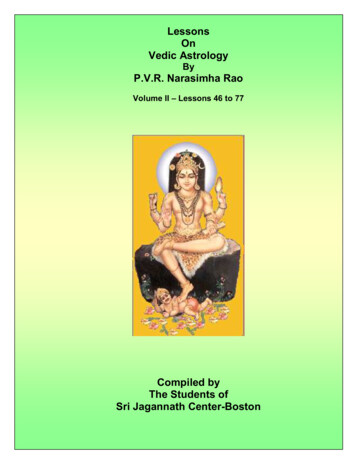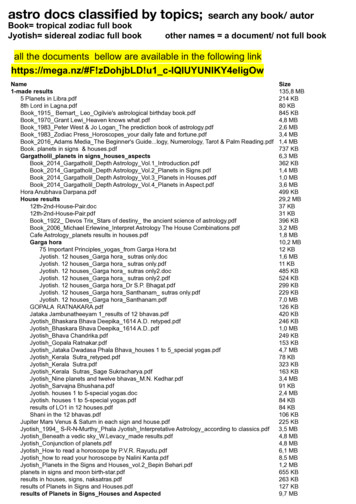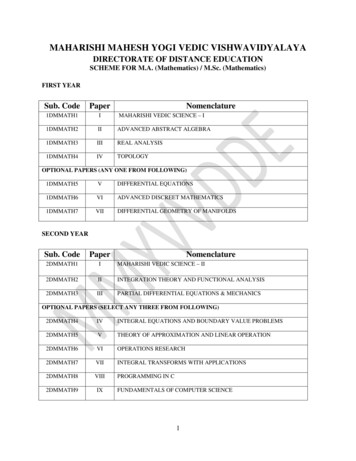
Transcription
MAHARISHI MAHESH YOGI VEDIC VISHWAVIDYALAYADIRECTORATE OF DISTANCE EDUCATIONSCHEME FOR M.A. (Mathematics) / M.Sc. (Mathematics)FIRST YEARSub. CodePaperNomenclature1DMMATH1IMAHARISHI VEDIC SCIENCE – I1DMMATH2IIADVANCED ABSTRACT ALGEBRA1DMMATH3IIIREAL ANALYSIS1DMMATH4IVTOPOLOGYOPTIONAL PAPERS (ANY ONE FROM FOLLOWING)1DMMATH5VDIFFERENTIAL EQUATIONS1DMMATH6VIADVANCED DISCREET MATHEMATICS1DMMATH7VIIDIFFERENTIAL GEOMETRY OF MANIFOLDSSECOND YEARSub. CodePaperNomenclature2DMMATH1IMAHARISHI VEDIC SCIENCE – II2DMMATH2IIINTEGRATION THEORY AND FUNCTIONAL ANALYSIS2DMMATH3IIIPARTIAL DIFFERENTIAL EQUATIONS & MECHANICSOPTIONAL PAPERS (SELECT ANY THREE FROM FOLLOWING)2DMMATH4IVINTEGRAL EQUATIONS AND BOUNDARY VALUE PROBLEMS2DMMATH5VTHEORY OF APPROXIMATION AND LINEAR OPERATION2DMMATH6VIOPERATIONS RESEARCH2DMMATH7VIIINTEGRAL TRANSFORMS WITH APPLICATIONS2DMMATH8VIIIPROGRAMMING IN C2DMMATH9IXFUNDAMENTALS OF COMPUTER SCIENCE1
MAHARISHI MAHESH YOGI VEDIC VISHWAVIDYALAYADIRECTORATE OF DISTANCE EDUCATIONSCHEME FOR M.A. (Mathematics) / M.Sc. (Mathematics)FIRST YEARSub. racticalMarksAssignmentMarksTotalMarksMAHARISHI VEDIC SCIENCE – I70-30100IIADVANCED ABSTRACT ALGEBRA70-301001DMMATH3IIIREAL ONAL PAPERS (ANY ONE FROM FOLLOWING)1DMMATH5VDIFFERENTIAL EQUATIONS70-1DMMATH6VIADVANCED DISCREET MATHEMATICS70-301001DMMATH7VIIDIFFERENTIAL GEOMETRY mentMarksTotalMarksSECOND YEARSub. CodePaperNomenclature2DMMATH1IMAHARISHI VEDIC SCIENCE – II70-301002DMMATH2IIINTEGRATION THEORY ANDFUNCTIONAL ANALYSIS70-301002DMMATH3IIIPARTIAL DIFFERENTIAL EQUATIONS &MECHANICS70-30100OPTIONAL PAPERS (SELECT ANY THREE FROM FOLLOWING)2DMMATH4IVINTEGRAL EQUATIONS ANDBOUNDARY VALUE PROBLEMS70-301002DMMATH5VTHEORY OF APPROXIMATION ANDLINEAR OPERATION70-301002DMMATH6VIOPERATIONS RESEARCH70-301002DMMATH7VIIINTEGRAL TRANSFORMS WITHAPPLICATIONS70-301002DMMATH8VIIIPROGRAMMING IN C5020301002DMMATH9IXFUNDAMENTALS OF COMPUTERSCIENCE70-301002
FUNDAMENTALS OF MAHARISHI VEDIC SCIENCE(MAHARISHI VEDIC SCIENCE – I)PG COURSESUNIT – IMeaning of Guru PujanName of 1-20 areas of Vedic Science & their expression in Human Physiology, detail withdiagramConsciousness – Characteristics and typesUNIT – IIMaharishi’s Yoga – Principles of Yoga Asans ,A general Introduction of T.M., T.M. & T.M.Sidhi ProgramTypes of SpeechUNIT – IIIThird law of Thermodynamics, Miessiner Effect, Maharishi EffectUNIT – IVIntroduction to Maharishi’s Vedic Swasthya Vidhan, Theories of Dincharya & Ritucharya,Theories of Ayurved.UNIT – VTheory of Invincibility. Introduction to Maharishi Jyotish.Suggested Readings:Maharishi Sandesh -1and 2 , II-His Holiness Maharishi Mahesh YogijeeScientific Yoga Ashanas –Dr.Satpal.Chetna Vigyan His Holiness Maharishi Yogi Ji.Dhyan Shailly by Brahmchari Dr. Girish Ji3
ADVANCED ABSTRACT ALGEBRAUNIT - IGroups – Normal and Subnormal series Composition Series Jordon-Holder theorem Solvable group.Nilpotent groups.UNIT - IICanonical forms – Similarity of linear transformation. Invariant subspaces. Reduction to triangularfarms . Nilpotent transformation . Index of nil potency. Invariants of a nilpotent transformation. Theprimary decomposition theorem. Jordan block and Jordon forms.Cyclic modules simple modules Semi-simple modules. Schuler’s Lemma Free modules.UNIT - IIIField theory – Extension fields. Algebraic and transcendental extensions. Separable and Inseparableextensions. Perfect field finite field primitive elements. Algebraically closed fields . Automorphsms . ofextensions, Galois extensions. Fundamental theorem of Galois theory Solution of polynomial equationsby radicals. Insolvability of the general equation of degree 5 by radicals.UNIT - IVNoetherian and artinian modules and rings – Hilbert basis theorem. Wederbum-ArtintheoremUniforma modules, primary modules, and Noether Lasker theorem.Smith normal form over a principal ideal domain and rank.UNIT - VFundamental Structure theorem for finitely generated modules over a principal ideal domain and itsapplications to finitely generated abelian groups. Rational canonical form. Generalised Jordan form overany field.4
REAL ANALYSISUNIT - IDefinition and existence of Riemann- Stielties integral, properties of the Integral, Integration anddifferentiation, the fundamental theorem of Calculus, integration of vector-valued functions, Rectifiablecurves.UNIT - IISequences and series of functions, point and uniform convergence, Cauchy criterion for uniformconvergence, Weierstrass M-test, Abel’s and Dirichlet’s tests for uniforms convergendce and continuity, uniforms convergence and Riemann-stielties integration, uniforms convergence and differentiation,Weierstrass approximation theorem, power series, uniqueness theorem for power series, Abel’s andTauber’s theorems.UNIT - IIIFunctions of sereral Variables, linear transformations, Derivatives in an open subset of R”, Chain rule,Partial derivatives, interchange of the order of differentiation, Derivatives of higher orders, Taylor’stheorem, Inverse function theorem, Implicit function theorem, jacobians, extremum problems withconstraints, lagrange’s multiplier method, Differentiation of Integrals, Partitions of unity, Differentialforms, Stoke’s theorem.UNIT - IVLebesgue outer measure. Measurable sets. Regularity. Measurable function . Borel and lebesguemeasurability. Non-measurable sets.Integration of Non-negative functions. The General integral, Integration of Series. Reimann and LebesgueIntegrals.The Four derivatives. Functions of Bounded variation. Lebesgue Differentiation Theorem. Differentiationand Integration.UNIT - VMeasures and outer measures, Extension of a measure. Uniqueness of Extension. Completion of ameasure. Integration with respect to a measure.The L- spaces. Convex functions, Jensen’s inequality. Holder and Minkowski inequalities. Completenessof L, Convergence in Measure, Almost uniform convergence.5
TOPOLOGYUNIT - ICountable and uncountable sets. Infinite sets and the Axiom of Choice, Cardinal numbers and its arithmetic.Schroeder-Bernstein theorem. Cantor’s theorem and the continuum hypothesis. Zorn’s lemma. Well-orderingtheorem.Definition and examples of topological spaces. Closed sets. Dense subsets. Neighbourhoods. Interior, exterior andboundary. Accumulation points and derived sets. Bases and sub-bases. Subspaces and relative topology.UNIT - IIAlternate methods of defining a topology in terms of Kuratowski Closrue Operator and Neighbourhood systems.Continuous function and homeomorphism.First and second countable spaces. Lindelof’s theorems. Separable spaces. Second Countability and Separability.UNIT - IIISeparation axioms T0, T1, T2, T3 ½ , T4, their characterizations and basic properties. Urysotin’s lemma. Tietzeextension theorem.Compactness. Continuous functions and compact sets. Basic properties of compactness. Compactness and finiteintersection property.Sequentially and countabley compact sets. Local compactness and one pointcompactification. Stone-vech compactification Compactness in metric . Equivalence of compactness, countablecompactness and sequential compactness in metric spaces.UNIT - IVConnected spaces. Connectedness on the real line. Components. Locally connected space.Tychonoff product topology in terms of standard sub-base and its characterizations. Projection maps. Separationaxioms and product space. Connectedness and produces. Compactness and product spaces (Tychonoff’s theorem) .Countabiltiy and product space.Embedding and metrization. Embedding lemma and Tychonolff embedding. The Urysohn metrization theorem.UNIT - VNets and filters. Topology and convergence of nets. Housdorffness and nets. Compactness and nets. Filters and theirconvergence. Canonical way of converting nets to filters and vice-versa. Ultra-filters and compactness.Metrization theorems and paracompactness-local finiteness . The nagata-smirnov metrization theorem .Paracompactness. The smirnov metrization theorem.The fundamental group and covering spaces – Homotopy of paths . The fundamental group. Covering spaces. Thefundamental group of the circle and the fundamental theorem of algebra.6
DIFFERENTIAL EQUATIONSUNIT - IHomegenous Linear Equation with Variable coefficient Simultaneous differential equation, Totaldifferential Equation.UNIT - IIPicard’s Method of Integration, successive Approximation, Existence Theorem, Uniqueness Theorem.Existence & Uniqueness theorem (All Proof by Picard’s method).UNIT - IIIDependence on initial conditions and parameters; Preliminaries. Continuity Differentiability, HigherOrder Differentiability.Poincare-Bendixson Theory-Autonomous systems. Umlanfsatz, Index of a stationary point., PoincareBendixson theorem. Stability of periodic solutions, rotation point, foci, nodes and saddle points.UNIT - IVLinear second order equations-Preliminaries, Basic facts. Theorems of sturm. Sturm-Liovville BoundaryValue Problems. Numbers of Zeros. Nonoscillatory equations and principal solutions. Nonoscillationtheorems.UNIT - VPartial differential Equation of first & Second order. Linear partial differential Equation with constantcoefficient.7
ADVANCED DISCRETE MATHEMATICSUNIT - IFormal Ligic – Statements, Symbolic Representation and Tautologies. Quantifiers, Predicates and Validity,Propositional Logic.Semigroups & Monoides-Definitions and Examples of Semigroups and Monoids (Including those pertaining toconcatenation operation). Homomorphism of semigroups and monoids. Congruence relation and QuotientSemigroups. Subsemigroup and submonoids. Direct products Basic Homomorphism Theorem.UNIT - IILattices – Lattices partially ordered. Their properties. Lattices as Algebraic system. Sublattices, Direct products,and Homomorphisms. Some Special Lattices e.g., Complete, Complemented and Distributive Lattices.Boolean Algebras – Boolean Algebras as Lattices, Various Boolean Identitios. The Switching Algebra example.Subalgebras, Direct Products and Homomorphisms. Join-irreducible elements, Atoms and Minterms. Booleanforms and Their Equivalence. Miniterm Boolean Forms, Sum fo Products Canonical Forms. Minimization ofBoolean Functions. Applications of Boolean Algebra to Switching Theory (Using AND, OR & NOT gates) Thekarnaugh Map method.UNIT - IIIGraph Theory – Definition of (Undirected) Graphs, Paths, Circuits, Cycle & Subgraphs. Induced Subgraphs.Degree of a vertex. Connectivity, Planar Graphs and their properties, Trees. Euler’s Formula for connected planarGraphs complete & Complete Bipartite Graphs, Kuratowski’s Theorem (statement only) and its use spanning Trees,Cut-sets,fundamental Cut-sets, and Cycle Minimal Spanning Trees and Kruskal’s Algorithm, MatrixRepresentations of Graphs, Euler’s Theorem on the Existence of Eulerian Paths and Circuits Directed Graphs.Indegree and Outdegree of a Vertex. Weighted undirected Graphs, Dijkstra’s Algorithm. Strong Connectivity &Warshall’s Algorithm. Directed Trees, Search Trees. Tree Traversals.UNIT - IVIntroductory Computability Theory – Finite state Machine and their Transition Table Diagrams. Equivalence ofFinite state Machines. Reduced Machines. Homomorphism, Finite Automata, Acceptors. Non-deterministic FiniteAutomata and equivalence of its power to that of Deterministic Finite Automata. Moore and Mealy Machines.Turing Machine and Partial Recursive Functions.UNIT - VGrammars and Lanuage – Phrase – Structure Grammars, Rewriting Rules, Derivations, Sentential Forms.Language generated by a Grammar. Regular; Context-Free, and Context Sensitive Grammars and Language ,Regular sets, Regular Expressions and the Pumping Lemma: Kleene’s theorem.Notions of Syntax Analysis, Polish Notations, Conversion of Infix Expressions to Palish Notations. The ReversePolish Notation.8
DIFFERENTIAL GEOMETRY OF MANIFOLDSUNIT - IDefinition and examples of differentiable manifolds. Tangent spaces. Jacobian. One parameter group oftransformations. Lie derivatives. Immersions and imabeddings. Distributions Exterior algebra, Exteriorderivative.UNIT - IITopological groups. Lie groups and lie algebras, Products of two Liegroups. One parameter subgroupsand exponential maps. Examples of Liegroups. Homomorphism and Isomorphism. Lie transformationgroups. General linear groups. Principal fibre bundle. Linear frame bundle. Associated fibre bundle.Vector bundle . Tangent bundle. Induced bundle. Bundle homomorphisms.UNIT - IIIRiemannian manifolds Riemannian connection. Curvature tensors. Sectional Curvature. Schur’s theoremGeodesics in a Riemannian manifold. Projective curvature tensor. Conformal curvature tensor.UNIT - IVSub manifolds & Hypersurfaces. Normals. Gauss formulae. Weigarten equations. Lines of curvature.Generalized Gauss and Mainardi-Codazziequations.UNIT - VAlmost Complex manifolds. Nijenhuis tensor. Contravariant and covariant almost analytic vector fields.F-connections.9
SECOND YEARADVANCED CONCEPTS OF MAHARISHI VEDIC SCIENCE(MAHARISHI VEDIC SCIENCE –II)PG COURSESUNIT – IName of 21-40 areas of Vedic Science & their expression in Human Physiology and detail with diagram.Consciousness, types of consciousness, characteristics of higher stages of consciousness.UNIT – IIIntroduction to Maharishi Gandharva VedaIntroduction to Maharishi Sthapatya VedUNIT – IIIIntroduction to Maharishi Vedic ManagementFundamental Elements of Vedic Management:- TotalityIdeal Management in Indian Society (Ashram Vavstha :Cast, Religious)Management Science and Art.UNIT – IVMaharishi Absolute theory of Defence.Maharishi Absolute theory of Development.Maharishi Absolute theory of Information.UNIT – VMaharishi’s Swasthya Vidhan.Scientific Research based on T.M. & T.M. Sidhi Programme.Suggested Readings:Maharishi Sandesh -1and 2 , II-His Holiness Maharishi Mahesh YogiJeeScientific Yoga Ashanas –Dr.Satpal.Chetna Vigyan His Holiness Maharishi YogiJee.Dhyan Shailly by Brahmchari Dr. Girish Ji10
INTEGRATION THEORY AND FUNCTIONAL ANALYSISUNIT - IIntegration Theory: Sinned measure. Hahn decomposition theorem, mutually singular measures, RadonNikodym theorem. Labesgue decomposition. Riesz representation theorem, Extension theorem(Caratheodory), Lebesgue-Stielitijes integral, product measures, Fubini’s theorem.UNIT - IIBaire sets. Baire measure, continuous functions with compact support. Regularity of measures on locallycompact spaces. Integration of continuous function with compact support, Riez-Markoff theorem.UNIT - IIIFunctional Analysis : Normed Linear Spaces, Banach Spaces with examples, Quotient space of normedlinear space and its completeness, bounded linear transformations, normed linear space of boundedlinear transformations, dual (conjugate) spaces with examples, natural imbedding of a normed linearspace in its second dual, open mapping theorem, closed graph theorem, uniform boundedness principleand its consequences.UNIT - IVFinite dimensional normed spaces and subspaces, Equivalent norms, finite dimensional normed linearspaces and compactness, Riesz lemma, Hahn Banach theorem for real linear space, complex linear space,and normed linear space, Adjoint operators, Reflexive spaces, Weak convergence, weak” Convergence.UNIT - VLnner product space, Hilbert space, Orthogonal Complements , Orthonormal sets, Bessel’s inequality,complete orthonormal sets and passeval’s identity, conjugate space H” and reflexivity of Hibert space,Adjoint of an operator on a Hilbert space , self-adjoint operators, positive, projection, normal and unitaryoperators.11
PARTIAL DIFFERENTIAL EQUATIONS & MECHANICSUNIT - IPartial Differential Equations : Examples of PDE. Classification. Transport Equation – Initial ValueProblem, Non homogeneous equation, Laplape’s equation-Fundamental Solution, Mean value formula,Properties of solutions, Energy Methods.Wave equation – Solution by Spherical Means, Non – Homogenous Equations, Energy Methods.UNIT – IINonlinear First Order PDE – Complete Integrals, Envelopes, Characteristics, Hamilton, Jacobi Equations(Colculus of Variations, Hamilton’s ODE, Legendre Transform, Hpf-Lax Formula, Weak Solutions,Uniqueness).Representation of solutions-Separation of variables, Similarity Solutions (Plane and Travelling Waves,Solutions, Similarity under Scaling) , Fourier and Laplace Transform, Hopf – Cole Transform,Hodograph and Legendra Transform, Potential Function.UNIT - IIIMechanics :- Analytical Dynamics : Generalized coordinates. Holonomic and Non-holonomic systems.Scleronomic and Rheonomic systems. Generalized potential. Lagrange’s equations of first kind.Lagrange’s equations of second kind. Uniqueness of solution. Energy equation for conservative fields.Hamilton’s variables, Donkin’s theorem Hamilton canonical equations. Cyclic coordinates Routh’sequations, Poisson’s Bracket. Poission’s Identity. Jacobi-Poisson Theorem.UNIT - IVHamilton’s Principle, Principle of least action. Poincare cartan Integral Invariant whittaker’s equations.Jacobis equations. Statement of Lee Hwo Chung’s theorem.Hamilton-Jacobi equation. Jacobi theorem. Method of spearction of variables Largrange Bracketsconoitin of canonical character of a Transformation interm of lagrange brackets and Peisson brackets.Invariance of Lagrange brackets and Poisson brackets under canonical transformations.UNIT - VGravitation: Attraction and potential of rod, disc, spherical shells and sphere. Surface integral of normalattraction (application & Gauss theorem) . Laplace and Poisson equations. Workdone by self attractingsystems. Distributions for a given potential. Equipotential Surfaces. Surface and solid harmonics surfacedensity in term of surface harmonics.12
INTEGRAL EQUATIONS AND BOUNDARY VALUE PROBLEMSUNIT - IDefinitions of Integral Equations and their classification. Eigen values and Eigen functions. Fredholmintegral equations of second kind with separable kemels. Reduction to a system of algebraic equations.An Approximate Method. Method of successive Approximations. Iterative scheme for fredholm Integralequations of the second kind. Conditions of uniform convergence and uniqueness of series solution.Resolvent kernel and its results. Application of Iterative Scheme to Volterra integral equations of theSecond kind . Classical Fredholm Theory. Fredholm Theorems.UNIT - IIIntegral Transform Method, Fourier Transform. Laplace Transform, Convolution integral. Application tovolterra integral equations with convolution – type kernels. Abel’s equations. Inversion formula forsingular integral equation with kenrnel of the type (h(s)-h(t)-a,O a 1. Cauchy’s Principal value ofsingular integrals. Solution on the Cauchy-type singular integral equation. The Hilbert kernel. Solution onthe Hilbert-type singular integral equation.UNIT - IIISymmetric kernels. Complex Hilbert Space. Orthonormal system of functions. Fundamental properties ofeigen values and eigen functions for symmetric kernels. Expansion in eigen function and bilinear form.Hilbert Schmidt Theorem and some immediate consequences solutions of integral equations withsysmmetric kernels.UNIT - IVDefinition of a boundary value problem for an ordinary differential equation of the second order and itsreduction to a Fredholm integral equation of the second kind. Dirac Delta function. Green’s functionapproach to reduce boundary value problems of a self-adjoint differential equation, with homogeneousboundary conditions to integral equation forms. Auxiliary problem satisfied by Green’s function.Integral equation formulations of boundary value problems with more general and inhomogeneousboundary conditions. Modified Green’s function.UNIT - VIntegral representation formulas for the solution of the Laplace’s and Poission’s equations. Newtoniansingle-layer and double layer potentials. Interior and exterior Dirichief and Neumann boundary valueproblems for Laplace’s equation Green’s function for Laplaces’s equation in a free space as well as inspace boundary by a ground vessel Integral equation formulation of boundary value problems forLaplace’s equation.13
THEORY OF APPROXIMATION AND LINEAR OPERATIONUNIT - IApproximation in normed spaces, Uniqueness, strict convexity, Uniform Approximation. Chebyshevpolynomials, Approximation in Hilbert space. Cubic Spline Interpolation.UNIT - IISpectral theory in Normed linear space, resolvent set and spectrum, spectral properties of bounded linearoperators. Properties of resolvent and spectrum. Spectral mapping theorem for polynomials. Spectralradius of a bounded linear operator on a complex Banach space Elementary theory of Banach algebras.UNIT - IIIGeneral properties of compact linear operators. Spectral properties of compact linear operator on normedspaces. Bhaviours of Compact linear operators with respect to solvability of operator equations.Fredholm type theorems. Fredholm alternative theorem. Fredholm alternative for integral equations.UNIT - IVSpectral progerties of bounded self-objoint linear operators on a complex Hilbert space. Positiveoperators. Manotone sequences theorem for bounded selfadjoint operators on a complex Hibert space.Square roots of a positive operator. Projection operators. Spectral family of a bounded self-adjoint linearoperator and its properties, spectral representation of bounded self adjoint linear operators. Spectraltheorem.UNIT - VUnbounded linear operators in Hilbert space. Hellinger---Toeplitz theorem . Hilbert adjoint operators,Symmetric and self-adjoint linear operators. Closed linear operators and closures. Spectral theorem forunitary and self-adjoint linear operators. Multiplication operator and Differentiation Operator.14
OPERATIONS RESEARCHUNIT - IOperations Research and its Scope. Linear Programming-Simplex Method. Theory of the SimplexMethod. Duality and Sensitivity Analysis.Other Algorithms for Linear Programming-Dual Simplex Method, Parametric Linear Programming .Upper Bound Technique Interior Point Algorithm. Linear Goal Programming.UNIT - IITransportation and Assignment Problems Network Analysis-Shortest Path Problem. Minimum SpanningTree Problem. Maximum Flow Problem. Minimum Cost Flow Problem. Network Simplex Method.Project Planning and Control With PERT-CPM.UNIT - IIIDynamic Programming-Deterministic and Probabilistic Dyanamic Programming . Game Theory – TwoPerson, Zero-Sum Games. Games with Mixed Strategies. Graphical Solution. Solution by LinearProgramming.UNIT - IVInteger Programming-Branch and Bound Technique, Simulation Replacement Problems, sequencing.UNIT - VNonlinear Programming-One and Multi-Variable Unconstrained Optimization. Kuhn-Tucker Conditionsfor Constrained Optimization. Quadratic Programming . Separable Programming. Convex Programming.Non-convex Programming.15
INTEGRAL TRANSFORMS WITH APPLICATIONSUNIT - IThe laplace transforms & its inversions: Definition. Laplace transform of elementary Sectionally continuous andexponential order function including its existence, some important properties of laplace transforms of derivativesand integrals. Multiplication and division by I periodic functions. Initial and final value theorems, laplacetransforms of some special functions. Definition and uniqueness theorem of inverse laplace transform. Inversion ofsome elementary functions, some properties of inverse laplace transform. Inverse laplace transform of derivativesand integrals. Multiplication and division by power of ‘s’ . The convolution property. Complex inversion formula,Heaviside expansion formula, Evaluation of intergrals.UNIT - IIApplication of laplace transforms. Ordinary differential equations with constant coefficients, ordinary differentialequations with variable coefficient. Simultaneous ordinary differential equations. Partial differential equations.Application to Mechanics, electrical circuits, beams. Application to solution of integral equations – integralequations of convolution type, Abel’s integral equation. Integro-Differential equation, difference and differentialdifference equations.UNIT - IIIFourier Series and Integrals : Fouries series, Odd and Even functions, Half range fourier sine and cosine seriescomplex form of fourier series, Rarseval’s Identity for founer sencs finite fourier transforms, the fourier integral/atincluding its complex form, fourier transforms, including sine and cosine transforms convolution theorem,Parseval’s identity for Fourier integrals. Relations between fourier and laplace transforms, Multiple finity fouriertransform Solution of simple partial differential equations by means fof fourier transformsUNIT - IVMellin and Hankel Transforms; Elementery properties of the Mellin Transforms, Mellin transforms of derivativesand Integrals Mellin-Inversion Theorem of Some. * The solution convolution Theorem integral equations. Thedistribution of Potntial in a wedge. Application to the summation of series. Elementary properties of Hankeltransforms Hankel Inversion Jheorem, Hankel transforms of the derivatives of functions and some elementaryfunciotn, Relations between lourier and Hankel Transform, Parseval Relation for Hankel Transforms, the use ofHankel Transforms in the solution of simple partial differential equations.UNIT - VApplication to Boundary value problems: Boundary value problems involving partial differential equations, ondimensional heat conduction equation, one dimerisional wave equation, longitudinal and transverse Vibration of abeam, Solution of boundary value problems by laplace transform. Simple boundary value problems withapplications of fourier transform .16
PROGRAMMING IN CUNIT - IAn overview of programming. Programming Language Classification of programming Language.Procedural oriented. Object oriented programming Language, Characteristics of a good programmingLanguage Introduction to C, Basic, Structure of C-Program Programming style Execution of C Program.C tokens, Keywords of Identifiers constants, Variables. Declaration of variable; Assigning value tovariable.UNIT - IIOperators and Expression Arithmetic , Operators, Relational Operator, Logical Operator, AssignmentOperator, Increment Operator, Decrement Operator, conditional operators, Bit wise operator, specialoperator Arithmetic Expression, Evaluation of Expression, Operator precedence & associativity . Inputand output statements. Formatted input &formatted output.UNIT - IIIDecision making and branching: it, else, nested if else, if Ladder, switch statements; ? Operator GOTOoperator; Looping statement:- While, do , for Jumps in Loops Arrays, one dimensional arrays, twodimensional array, multidimensional array. Pointers, Declaration of pointer accessing the address of avariable, initiating pointers, accessing a variable through its pointer. Pointer and arrays, pointer andfunction, pointer and structure.UNIT - IVHandling of character strings, declaring and initializing string variables. String Handling functions Userdefined function form of C-function, Return values & their types, calling a function by value & referenceNesting of function recursion, function with array & structures and union , structure initialization array ofstructures, structure within structure, structure and function.UNIT - VFile management in C, Defining & Opening a file, closing a file, Input/output operations on file Errorhand I/O operator Random access to the files, Command, line argument Preprocessors- Macrosubstitution, ANSI editions computer control directives.17
FUNDAMENTALS OF COMPUTER SCIENCEUNIT - IPrinciples of object oriented programming object oriented paradigm, Basic concept of object orientedprogramming, Benefits of OOPs, objected oriented language, application of OOPs. Introduction to C ,Structure of Program. Compiling & linking of C Program.UNIT - IIClasses, objects ,constructor and Destructor operator overloading and type conversion, Inheritance, singleInheritance, Multilevel Inheritance, pointers, virtual functions and polymorphism Templates, classTemplate, function Templates, New ANSI C features object oriented systems development procedureoriented paradigm, Development Tools, object oriented paradigm.UNIT - IIIIntroduction to data base systems, operational Data, Data independence, data base system architectureRelational approach to data structures Relations, Domain and attributes, keys, Extension, Relational Datamanipulations, Relational Algebra and relational calculus. SQL – basic features, Integrity constraintsDatabase design – Normalization up to BCNF.UNIT - IVData structure –Date types – Classification of data structure linked lists, stalk & Queues, Operation ofLists Stack & Queues, Algorithm for lists stack & Queue Trees properties of tree, Types : - Binary,Binary search, Tree, B-Tree Hashing Techniques Sorting Techniques – Selection sorts Bubble sort,Quick sort, heap sort.UNIT - VOperating system, Services: offered classification of O/S Function of O/S process Management, fileManagement Memory Management I/O Management concept of virtual memory, security threadsprotection intruders; virus trusted system, Introduction to Distributed systems.18
maharishi mahesh yogi vedic vishwavidyalaya directorate of distance education scheme for m.a. (mathematics) / m.sc. (mathematics) first year sub. code paper nomenclature 1dmmath1 i maharishi vedic science – i 1dmmath2 ii advanced abstract algebra 1dmmath3 iii real analysis 1dmm

